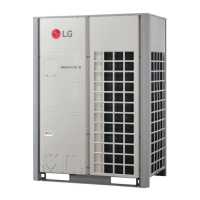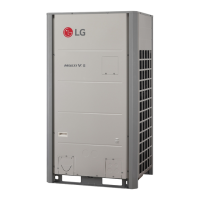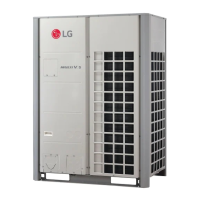
Do you have a question about the LG MULTI V 5 ARUN120BTE5 and is the answer not in the manual?
| Model | ARUN120BTE5 |
|---|---|
| Category | Air Conditioner |
| Refrigerant | R410A |
| Power Supply | 380-415V, 3Ph, 50Hz |
| Operating Temperature (Cooling) | -5°C to 48°C |
| Type | Outdoor Unit |
| Indoor Unit Type | Compatible with various LG indoor units |
| Operating Temperature (Heating) | -25°C to 24°C |
Section for recording purchase details and serial numbers for warranty.
Precautions for licensed electricians, grounding, circuit protection, and authorized technicians.
Precautions for power cords, outlets, water contact, wet hands, and sharp edges.
Safety advice on gas leakage, noise, combustible gas, pipe ratings, and special purposes.
Safety advice on environment, connections, base collapse, drain hose, and transportation.
Details on combining outdoor units and their connection ratios.
Information on R410A refrigerant properties, pressure, and composition.
Minimum space requirements for outdoor unit installation for optimal operation.
Instructions for safely lifting and carrying the outdoor unit using ropes or forklifts.
Guidelines for installing outdoor units in snowy or cold areas and protection from wind.
Specifies the location and requirements for anchor bolts during installation.
Details on ensuring the support is strong enough and level for the outdoor unit.
Steps for preparing pipes, including cutting and flaring, to prevent leakage.
Procedures for removing burrs from pipes and performing flaring for connections.
Guidelines for correct flare shape and appropriate torque for nut connections.
Instructions for opening and closing shutoff valves using a hexagon wrench.
Safety and procedural advice for connecting pipes, including oil application and leak checks.
Requirements for pipe materials and proper storage to prevent contamination.
Procedure for using nitrogen during welding to prevent oxide film formation.
Key principles for refrigerant piping concerning drying, cleanliness, and airtightness.
Guidelines for connecting pipes and operating valves, with safety warnings.
Illustrates different connection methods for multiple outdoor units.
Details on using Y branch and header fittings for connecting multiple indoor units.
Advice on pipe diameter, length restrictions, and connections for multi-branch systems.
Steps for preparing the outdoor unit base pan for pipe routing.
Procedure to remove the leakage prevention cap before starting pipe work.
Illustrates methods for drawing out pipes from the front and bottom of the unit.
Diagrams for connecting multiple outdoor units in series using Y branch or header methods.
Explains pipe configurations for header method connections.
Tables specifying pipe diameters based on ODU capacity, length, and height difference.
Details on maximum pipe lengths and conditional application rules for connections.
Guidelines for pipe diameter B when it's larger than main pipe A in outdoor unit combinations.
Specifies pipe sizes for indoor unit connections based on capacity.
Advice on connecting outdoor units in series, including oil traps and wrong connection examples.
Instructions for fitting Y branch pipes, including orientation and insulation.
Guidelines for header fittings and using a pipe cutter for connections.
Instructions for insulating headers and sealing joints between pipes and headers.
Guidance on insulating cap pipes with provided insulators and tape.
Illustrates horizontal, vertical, and other distribution methods for connecting units.
Procedure for creating vacuum in the system after component replacement or addition.
Steps for performing leak tests with nitrogen and vacuum drying of the system.
Warnings against using air or oxygen for leakage tests and air purging.
Detailed steps for performing vacuum drying using a vacuum pump, including moisture removal.
Guidelines for charging refrigerant, including system setup and pressure checks.
Formula and method for calculating additional refrigerant charge based on pipe length and indoor unit CF value.
Importance of proper insulation for refrigerant pipes to prevent condensation and ensure efficiency.
Illustrates good and bad examples of pipe insulation and associated warnings.
Methods for sealing wall penetrations for pipes and wires to prevent air and moisture ingress.
Adherence to electrical codes, use of qualified engineers, and grounding requirements.
Guidelines for installing communication cables, keeping them separate from power wiring.
Rules for using shielded wires, grounding, and avoiding multi-core or power cables.
Advice on using appropriate terminals, preventing mixed wire thicknesses, and securing cables.
Identifies wiring points within the control box for main/sub outdoor units and indoor units.
Recommendations for spacing communication and power cables to prevent interference.
Illustrates wiring configurations for single and series outdoor units.
Tables for selecting wire sizes based on capacity and grounding requirements.
Specifies minimum wire sizes for connections between master and slave outdoor units.
Explains BUS and STAR type connections for communication cables between units.
Details on connecting power and communication cables on the bottom and front sides of the UXA unit.
Methods for connecting communication cables between indoor and master outdoor units.
Procedures for checking and setting outdoor unit configurations via dip switches and displays.
Instructions for making quick control settings using dip switches and reset buttons.
Guide for setting master/slave configurations using dip switches.
Detailed procedure for automatic addressing of indoor units to outdoor units.
How to select and set optional functions using buttons and dip switches.
List of optional modes for Fan Drive Device (FDD) and their settings.
How to set the cooling and heating modes using the selector and PCB DIP switch.
Function to maintain ODU airflow when ducts are used, with setting methods.
Reduces ODU fan RPM at night to lower noise levels, with setting methods.
Procedure for setting the address for outdoor units using mode and function selections.
Settings for snow removal and rapid defrost modes, including mode and function selection.
Adjusts indoor unit airflow when capacity exceeds 130%, with setting methods.
Allows adjustment of target pressure based on mode, purpose, and temperature variations.
Enables operation in low ambient temperatures, with setting methods.
Adjusts target low pressure for ODU temperature in cooling operation for efficiency.
Sets the maximum operating frequency for the compressor, with setting methods.
Enables reverse run of outdoor fan to remove dust from the heat exchanger.
Sets the maximum rotational speed limit for the outdoor unit fan.
Provides RPM limit values for different chassis and operating conditions.
Sets variable target pressure for high efficiency and comfort operation based on ODU load.
Configures humidity sensor usage for cooling and heating operations.
Details on connecting the central control system to the indoor unit side.
Sets limits on the compressor's input current for operational control.
Enables display of power consumption on the wired remote controller.
Activates the base pan heater to prevent freezing in cold areas.
Manages defrost operations during low temperatures in heating mode.
Reduces ODU energy consumption through continuous operation without thermo off.
Explains how error numbers and unit numbers are displayed for self-diagnosis.
Lists errors related to indoor unit sensors, communication, and components.
Lists errors related to outdoor unit sensors, compressor, voltage, and switches.
Details errors related to inverter compressor start failure, over current, and temperature faults.
Lists errors for pressure, temperature, fan, and IPM sensors and switches.
Errors indicating communication failures or issues with EEPROM data.
Errors related to outdoor unit fan voltage, liquid pipe, subcooling sensors, and oil level.
Errors concerning main board communication, Hydro-Kit, and fan heatsink temperature.
Indicates errors related to network communication defects.
Emphasizes securing safety against leaks according to local standards.
Defines Freon gas concentration limits for human safety and calculation methods.
Proposes ventilation, leak alarms, and system division as countermeasures for high concentration.
Step-by-step guide to check refrigerant concentration and take appropriate measures.
Advises against installing in corrosive areas or directly exposed to sea wind to prevent corrosion.
Guides on selecting a location and using windbreaks to protect the unit from sea wind.
Provides data on sound pressure levels and factors influencing noise exposure.












